
The Boston Public Library is a municipal public library system in Boston, Massachusetts, founded in 1848. The Boston Public Library is also Massachusetts' Library for the Commonwealth, meaning all adult residents of the state are entitled to borrowing and research privileges, and the library receives state funding. The Boston Public Library contains approximately 24 million items, making it the third-largest public library in the United States behind the federal Library of Congress and New York Public Library, which is also privately endowed. In 2014, the library held more than 10,000 programs, all free to the public, and lent 3.7 million materials.

West Boylston is a town in Worcester County, Massachusetts, United States and a northern suburb of Worcester. The population was 7,877 at the 2020 census. West Boylston includes the village of Oakdale, located on the opposite side of the Wachusett Reservoir from West Boylston center along Route 140. Although the town was split off from Boylston, it has a larger population than its eastern namesake.

The Boston Common is a public park in downtown Boston, Massachusetts. It is the oldest city park in the United States. Boston Common consists of 50 acres (20 ha) of land bounded by Tremont Street, Park Street, Beacon Street, Charles Street, and Boylston Street.

The Cutler Majestic Theatre at Emerson College, in Boston, Massachusetts, is a 1903 Beaux Arts style theater, designed by the architect John Galen Howard. Originally built for theatre, it was one of three theaters commissioned in Boston by Eben Dyer Jordan, son of the founder of Jordan Marsh, a Boston-based chain of department stores. The Majestic was converted to accommodate vaudeville shows in the 1920s and eventually into a movie house in 1956 by Sack Cinemas. The change to film came with renovations that transformed the lobby and covered up much of John Galen Howard's original Beaux-Arts architecture.

Nathaniel Jeremiah Bradlee was a Boston architect and a partner in the firm of Bradlee, Winslow & Wetherell.

The Arlington Street Church is a Unitarian Universalist church across from the Public Garden in Boston, Massachusetts. Because of its geographic prominence and the notable ministers who have served the congregation, the church is considered to be among the most historically important in American Unitarianism and Unitarian Universalism. Completed in 1861, it was designed by Arthur Gilman and Gridley James Fox Bryant to resemble James Gibbs' St. Martin-in-the-Fields in London. The main sanctuary space has 16 large-scale stained-glass windows installed by Tiffany Studios from 1899 to 1930.

The Tremont Street subway in Boston's MBTA subway system is the oldest subway tunnel in North America and the third oldest still in use worldwide to exclusively use electric traction, opening on September 1, 1897. It was originally built, under the supervision of Howard A. Carson as chief engineer, to get streetcar lines off the traffic-clogged streets, instead of as a true rapid transit line. It now forms the central part of the Green Line, connecting Boylston Street to Park Street and Government Center stations.

The Massachusetts Historical Society (MHS) is a major historical archive specializing in early American, Massachusetts, and New England history. The Massachusetts Historical Society was established in 1791 and is located at 1154 Boylston Street in Boston, Massachusetts, and is the oldest historical society in the United States.
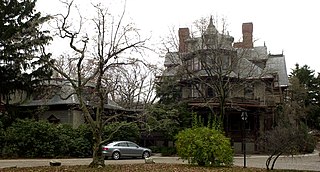
The Adams-Nervine Asylum was incorporated in 1877 and opened in 1880 in Jamaica Plain, Massachusetts. The estate provided an attractive, picturesque setting, as it was situated on Centre Street, in the neighborhood of Bussy Park and the Arnold Arboretum. Having previously been owned by J. Gardiner Weld, it was purchased by Seth Adams with his fortune acquired from his sugar refinery in South Boston. With his brother Isaac, Seth had formerly manufactured printing presses and machinery. On his death, his estate bequeathed $600,000 for the establishment of a curative institution for the benefit of indigent, debilitated and nervous people: inhabitants of the State who were not insane. The trustees purchased neighboring properties for the Asylum in 1879.The estate was vacated in 1976 and left to The Adams Trust.

The Blackstone Block Historic District encompasses what was once a waterfront business area in Boston, Massachusetts. Due to the infill of land it is now slightly inland from the waterfront. The district is bounded by Union, Hanover, Blackstone, and North Streets, not far from Quincy Market and Faneuil Hall. It includes the Union Oyster House, a National Historic Landmark building erected in the 1710s, and a collection of commercial buildings dating from the late 18th and 19th centuries. The district was added to the National Register of Historic Places in 1973. It also includes the c. 1770s Ebenezer Hancock House, a Federal-style wood-frame house that is the only building left in the city which was known to be owned by John Hancock. The building was designated a Boston Landmark by the Boston Landmarks Commission in 1978 for its notable exterior and interiors. In 1983, the surrounding ca. 1676 Blackstone Block Street Network was also designated by the Boston Landmarks Commission.

YMCA Boston was founded in 1851 in Boston, Massachusetts, as the first American chapter of YMCA.

The Boylston Building is an historic building at 2–22 Boylston Street in Boston, Massachusetts. The six-story sandstone building was designed by Carl Fehmer and built in 1887 by Woodbury & Leighton. It is an early instance in Boston of a skeleton-built commercial structure, rather than having load-bearing masonry walls. The building housed the Boylston Market, a wholesale trading exchange which had been on the site since 1810.
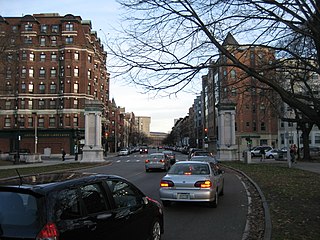
The Fenway-Boylston Street District is a historic district encompassing a series of predominantly residential buildings lining The Fenway in the Fenway–Kenmore of Boston, Massachusetts. Developed beginning in the 1890s, the area is emblematic of Boston's upper-class residential development of the period, with architect-designed houses built for some of the city's leading families. The district was listed on the National Register of Historic Places in 1984.

The Donald McKay House is a privately owned historic house at 78–80 White Street in East Boston, Massachusetts. It was the residence of Donald McKay, a builder of clipper ships.

The Jacob Wirth Restaurant was a historic German-American restaurant and bar in Boston, Massachusetts, at 31-39 Stuart Street. Founded in 1868, Jacob Wirth was the second oldest continuously operated restaurant in Boston when it closed in 2018.
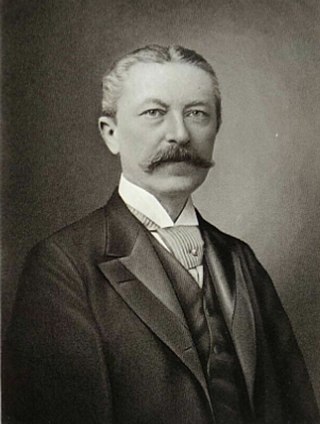
Carl Fehmer was a prominent German-American Boston architect during the 19th century.

Boylston Market (1810-1887), designed by architect Charles Bulfinch, was located in Boston, Massachusetts, on the corner of Boylston and Washington Streets. Boylston Hall occupied the third floor of the building, and functioned as a performance and meeting space.
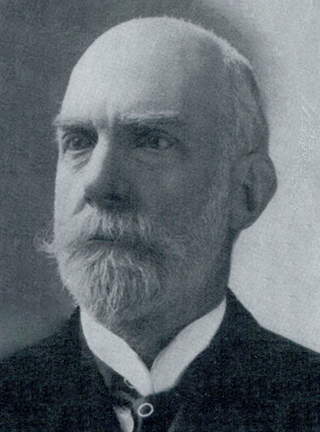
William Gibbons Preston was an American architect who practiced during the last third of the nineteenth century and in the first decade of the twentieth. Educated at Harvard University and the École des Beaux-Arts in Paris, he was active in Boston, New York, Rhode Island, Ohio, New Brunswick and Savannah, Georgia, where he was brought by George Johnson Baldwin to design the Chatham County courthouse. Preston stayed in Savannah for several years during which time designed the original Desoto Hotel, the Savannah Volunteer Guards Armory and 20 other distinguished public buildings and private homes. He began his professional career working for his father, the builder and architect Jonathan Preston (1801–1888), upon his return to the United States from the École in 1861, and was the sole practitioner in the office from the time his father retired c. 1875 until he took John Kahlmeyer as a partner in about 1885.
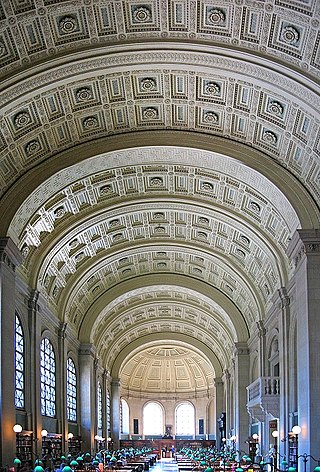
The McKim Building is the main branch of the Boston Public Library at Copley Square in Boston, Massachusetts. The building, described upon its 1895 opening as a "palace for the people", contains the library's research collection, exhibition rooms, and administrative offices. The building includes lavish decorations, a children's room, and a central courtyard surrounded by an arcaded gallery in the manner of a Renaissance cloister. The library regularly displays its rare works, often in exhibits that will combine works on paper, rare books, and works of art. Several galleries in the third floor of the McKim building are maintained for exhibits.
A Boston Landmark is a designation by the Boston Landmarks Commission for historic buildings and sites throughout the city of Boston based on the grounds that it has historical, social, cultural, architectural or aesthetic significance to New England or the United States. While National Landmark or National Register status can provide tax incentives for the owner of an income-producing property, local landmark status provides more control over modifications to a designated historic structure or place.
























